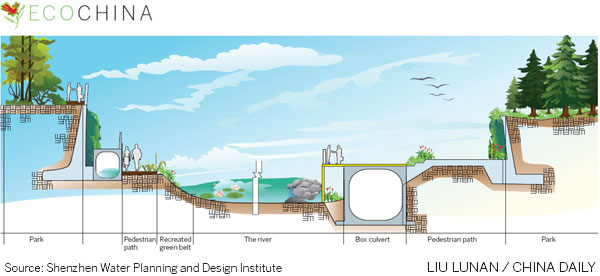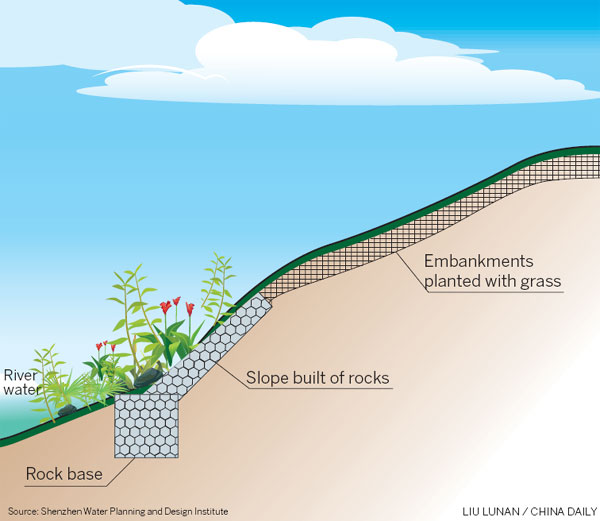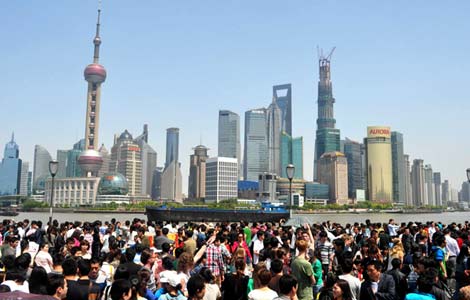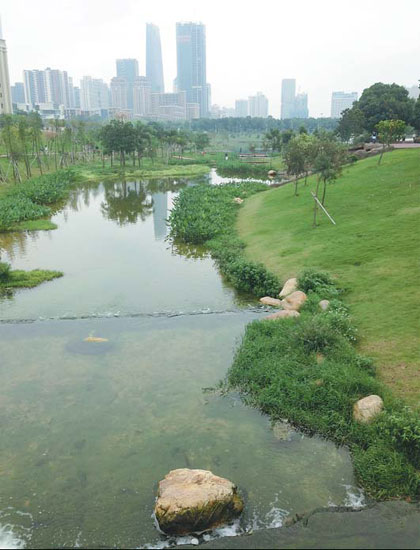Saving urban water
Updated: 2013-07-11 07:31
By Cang Lide (China Daily)
|
||||||||


It is a relatively new city on the Chinese landscape, and it had its share of teething problems in its rapid evolution from farmland community to industrial hub. Cang Lide looks at the eco-salvage solutions in Shenzhen.
The Futian River runs through the heart of bustling Shenzhen, a Guangdong city that shares a boundary with Hong Kong and is the province's shining example of urban planning.
A walk along its banks is a refreshing experience. The air is pure and fresh, ionized by rippling brooks and gently splashing waterfall walls. Trees of varied heights break up the skyscraper-defined skyline, and the banks and slopes are landscaped with bushes, flowers and grass, with sections of wetland vegetation nestled in the curves of the river.
Pedestrians stroll along the walkways by the river, gazing into the clear waters as tiny fish dart among the pebbles. The occasional fishermen hides in a few choice corners, pulling in catches of freshwater fishes such as carp and perch.
It's a weekday, but we see parents playing with their children, young people cycling, and people walking their dogs. It seems like a scene out of the idyllic countryside but we are actually in downtown Shenzhen.
It is hard to imagine that this is the heart of such a highly industrialized metropolis, especially when so many major cities in China are suffering the ravages of habitat pollution.
Water, especially water management, has become a major concern throughout the country - along with problems in waste treatment, contamination in rivers and the water table and the deterioration of the environment.
Not so long ago, Shenzhen was in the same woeful state.
After 30 years of breathtaking growth, this former fishing and farming village has grown into one of the most densely populated cities in the world - with 14 million people living in a space of 1,952 sq km. By 2000, all of its water sources were contaminated.
The 7-km-long Futian River became dark and smelly. Neither fish nor shrimp were visibly apparent and passers-by held their breath and quickened their steps.
So what was the catalyst behind this extraordinary change from dirty sewer to sparkling waters?
"Taking lessons from other countries, such as Japan and Singapore, we combined our studies in water conservancy engineering, environmental engineering, biological science, eco-science, urban planning, landscape and gardening, and created a plan of comprehensive improvement for Futian River," says Zhu Wenbo, deputy director of the Shenzhen Water Planning and Design Institute and the man behind this metamorphosis.
That was the short answer.
The longer version involved 10 years of planning and plotting and the desperate conviction that if something was not done, the city was going to lapse into eco-disaster.
Zhu says the highly concentrated land use in the past had placed the river system in a tightening vice, and drastically reduced its hinterland. Initially, water conservancy engineering was targeted only as a means of flood control and wastewater discharge.
As a result, the ecosystem of the river was severely disturbed, even destroyed.
Under Zhu, the institute was commissioned to revive the natural functions of rivers, both natural and social, and to reshape the harmonious relationship between the river courses and the residents of the city.
The institute's aims were to recover the river's ecological and social environmental functions to improve Shenzhen's living habitat, and by direct relation, the city's competitiveness as a venue for investment. They also needed to make sure all solutions were sustainable.
In 2009, the Shenzhen Futian River project was launched.
First, reservoirs for flood discharge and culverts to divert overflow were built along the main course.
Unlike other cities which often neglect rainwater, Shenzhen channeled surface wastewater into sluiceways, and built a sewage control tank in the pluvial area of the Futian River.
As a result, rainfall in the rainy season, and almost all sewage water in the dry season have been collected by the system. The water is then diverted to sewage disposal plants and recycled after treatment.
In designing their grand plan, Zhu says the engineers have followed the original designs of nature.
Concrete embankments erected in the past were replaced by rocks and pebbles. Sand, mud and pebbles created long strips of wetland along some parts of the bank.
With some 40 million tons of recycled water drained into the Futian River every year, these wetlands with their thick bushes and weeds have played a vital role in filtering and purifying the water, turning it into a natural, clean water source that is almost as good as natural.
After three years of hard work and 300 million yuan ($49 million), the water quality of the Futian was upgraded from a filthy category IV to a pristine category II.
The standard for flood control has also been raised, reducing the possibility from once in 10 years to once in 100 years.
At the same time, three large scenic lakes have emerged. Lush green plants grow alongside and special greenways have been paved for cyclists and joggers.
From being an eyesore and health hazard, the Futian has become Shenzhen's green lung and its residents' favorite park.
There are more success stories waiting to happen, including ambitious plans for comprehensive water control projects. All are near completion, such as work on the Shenzhen Reservoir, Guanlan River, Houhai River and Longgang River. Work continues on the Qianhai Reclamation project.
In the next two years, Shenzhen is planning to build a catchment area covering 550 square km, with the aim of capturing precious rainwater, and creating additional green space for its inhabitants to commute with nature.
The guiding principles of the Shenzhen eco-salvage water projects are simple: Infrastructure underground must be in direct correlation with development above ground. The best designs follow the natural course. And finally, the environment is the city's best asset and selling point.
Shenzhen has become a city with a beautiful river flowing through it. Hopefully, other major cities in China will look toward its example and learn a thing or two from the Futian River and its protectors.
Contact the writer at canglide@chinadaily.com.cn.
Pauline D. Loh contributed to the story.
|
Skycrappers loom over the Futian River after the eco-salvage project from 2008 to 2011. Cang Lide / China Daily |
(China Daily USA 07/11/2013 page8)

 China, Russia complete 3-day joint naval drill
China, Russia complete 3-day joint naval drill
 US drone completes 1st carrier landing
US drone completes 1st carrier landing
 Sino-US talks 'help build trust'
Sino-US talks 'help build trust'
 Boston Marathon bombing suspect pleads not guilty
Boston Marathon bombing suspect pleads not guilty
 Caution urged in seeking experts from abroad
Caution urged in seeking experts from abroad
 Shanghai struggles with growth
Shanghai struggles with growth
 Trade town turns to tourism
Trade town turns to tourism
 Project focuses on unmarried youths
Project focuses on unmarried youths
Most Viewed
Editor's Picks

|

|

|

|

|

|
Today's Top News
Smithfield CEO quells fears over Chinese purchase
Beijing has world's most delayed airport
Caution urged in seeking experts from abroad
Snowden is likely Venezuela bound
Talks 'help build trust' between China, US
Obama pushes House Republicans on immigration
Chinese researcher pleads guilty in US drug case
US Navy completes 1st unmanned carrier landing
US Weekly

|

|






